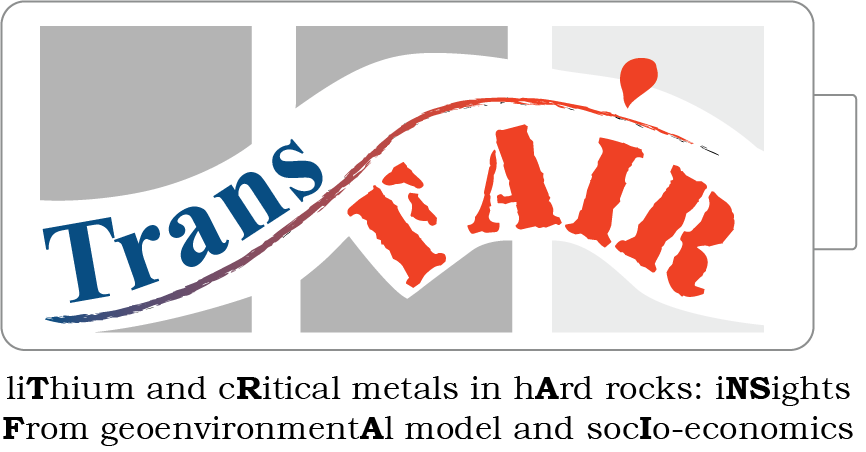
TRANSFAIR
Date de début : 11/01/2021
Date de fin : 04/30/2026
Numéro de contrat
Durée de projet
54 months
Financement
ANR
Montant
Coordinateur : Jérémie Melleton (BRGM)
Partenaires :
BRGM
ISTO
ISTEP (Université Pierre et Marie Curie, Paris)
CRPG (CNRS- Nancy)
EDYTEM ENVIRONNEMENTS, DYNAMIQUES ET TERRITOIRES DE LA MONTAGNE (Université Annecy – Chambéry)
GEORESSOURCES (Université Nancy)
IEIC Entreprise
Imerys Entreprise
IRD – UMR GET (Géoscience Toulouse, Université Toulouse)
Technologies related to renewable energies are very consuming in rare metals (Li, Ta, Sn for example). In Europe, a significant part of the resources corresponds to rare metal pegmatites and granites (RMPG), known in particular in the Variscan massifs, such as the Massif Central in France (MCF) or the Iberian Variscan domain. To meet the needs of the energy transition, a sustainable supply chain for lithium and tantalum must be based on the exploitation of these European RMPG deposits, but its economic, environmental and social impacts must be assessed. The geological processes at the origin of these deposits, i.e. the metallogenic model, are still poorly known, notably because of the very particular character of these magmatic rocks. This makes it difficult to predict areas with potential for new discoveries. The TRANSFAIR project, a consortium bringing together transdisciplinary expertise between geosciences and humanities, will produce a comprehensive metallogenic model that will allow the development of predictive mapping approaches at the district and deposit scale. To achieve this goal, TRANSFAIR will use two emblematic examples of known mineralization in the MCF and Iberia, common learning grounds for all project activities. On the basis of recent developments, TRANSFAIR proposes to study the hypothesis of an origin associated with the partial melting of sedimentary sources particularly rich in lithium, by an innovative experimental approach coupled with a characterization of natural objects in the field. The migration and crystallization processes of magmatic liquids, which are major parameters to explain the localization of mineralizations, will be better constrained by a coupled approach of experimental petrology and numerical modelling. These results will be compared to natural cases through a 3D understanding of the structural and tectonic context of the mineralizations, using new geophysical acquisitions and field surveys. A better knowledge of the magmatic history of the RMPG zones, from partial melting to the emplacement of barren and mineralized magmas, will be built from geochemical, geochronological and isotopic characterizations. All these results will be integrated for the construction of predictive maps of zones favourable to the presence of RMPG. In a perspective of significant development of the mining activity inherent to the increasing demand for lithium, TRANSFAIR will allow to distinguish the benefits and drawbacks of new mines exploiting European RMPG, and will bring the keys for the societal engagement in the new mining projects. TRANSFAIR will thus focus on the determination of key economic parameters for the valuation of European RMPG, using an econometric approach. The environmental impacts of these domestic operations will be compared to the current market, based on existing literature and life cycle analyses. Finally, the potential levels of acceptability of mining projects in France, Portugal and Spain will be assessed through a characterization of territorial profiles, a mapping of stakeholders and the adaptation of the social risk index.
To answer the current needs in critical metals, TRANSFAIR will thus bring solutions which will allow a better knowledge and valorization of the European potential, by giving keys for a more effective exploration, but also for a better basis of understanding between the citizens, institutions and industrialists.


